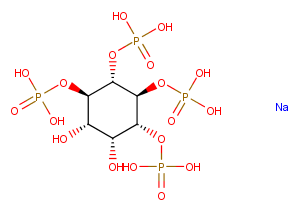D-myo-Inositol-1,4,5,6-tetraphosphate (sodium salt)
| Code | Size | Price |
|---|
| TAR-T35933-1mg | 1mg | £1,173.00 | |||||||||||||||||||||||||||||||||||||||||||||||||||||||||||||||||||||||||||||||||||||||||||||||||
| Special offer! Add £1 to your order to get a TargetMol CCK-8 Kit. Read more here. | |||||||||||||||||||||||||||||||||||||||||||||||||||||||||||||||||||||||||||||||||||||||||||||||||||
Quantity:
Prices exclude any Taxes / VAT
Overview
Regulatory Status: RUO
Shipping:
cool pack
Storage:
-20℃
Images
Documents
Further Information
Bioactivity:
D-myo-Inositol-1,4,5,6-tetrahosphate (sodium salt) (Ins(1,4,5,6)-P4) is one of several different inositol oligophosphate isomers implicated in signal transduction. Production of Ins(1,4,5,6)-P4 by intestinal epithelial cells increases approximately 2-14 fold, depending on the strain and incubation time, following infection with Salmonella.[1] D-myo-Inositol-1,4,5,6-tetraphosphate (sodium salt) (Ins(1,4,5,6)-P4) is one of several different inositol oligophosphate isomers implicated in signal transduction. Production of Ins(1,4,5,6)-P4 by intestinal epithelial cells increases approximately 2-14 fold, depending on the strain and incubation time, following infection with Salmonella. Ins(1,4,5,6)-P4 antagonizes epidermal growth factor (EGF) signalling through the phosphatidylinositol 3-kinase pathway. Ins(1,4,5,6)-P4 (tested as the D/L racemic mixture) is ~1,000-fold less potent than Ins(1,4,5)-P3 at initiating Ca2+ release when injected into Xenopus oocytes.[2]
CAS:
157542-47-7
Formula:
C6H12O18P4?4Na
Molecular Weight:
588
Purity:
0.98
SMILES:
O[C@@H]1[C@H](O)[C@@H](OP([O-])(O)=O)[C@H](OP([O-])(O)=O)[C@@H](OP([O-])(O)=O)[C@@H]1OP([O-])(O)=O.[Na+].[Na+].[Na+].[Na+]
References
Eckmann, L., Rudolf, M.T., Ptasznik, A., et al. D-myo-Inositol 1,4,5,6-tetrakisphosphate produced in human intestinal epithelial cells in response to salmonella invasion inhibits phosphoinositide 3-kinase signaling pathways. Proceedings of the National Academy of Sciences of the United States of America 94, 14456-14460 (1997).
DeLisle, S., Radenberg, T., Wintermantel, M.R., et al. Second messenger specificity of the inositol trisphosphate receptor: Reappraisal based on novel inositol phosphates. American Journal of Physiology.Cell Physiology 35, C429-C436 (1994).



